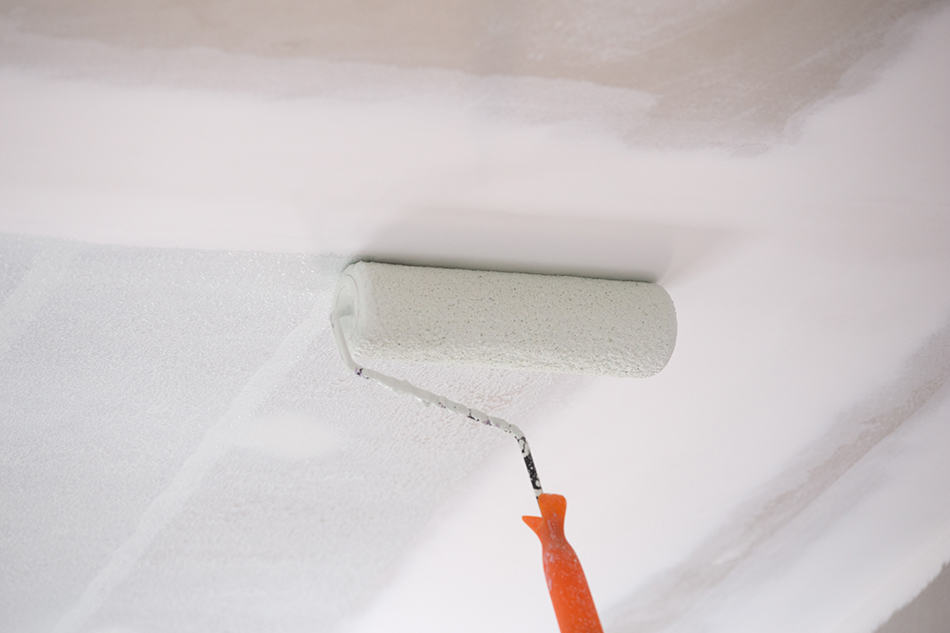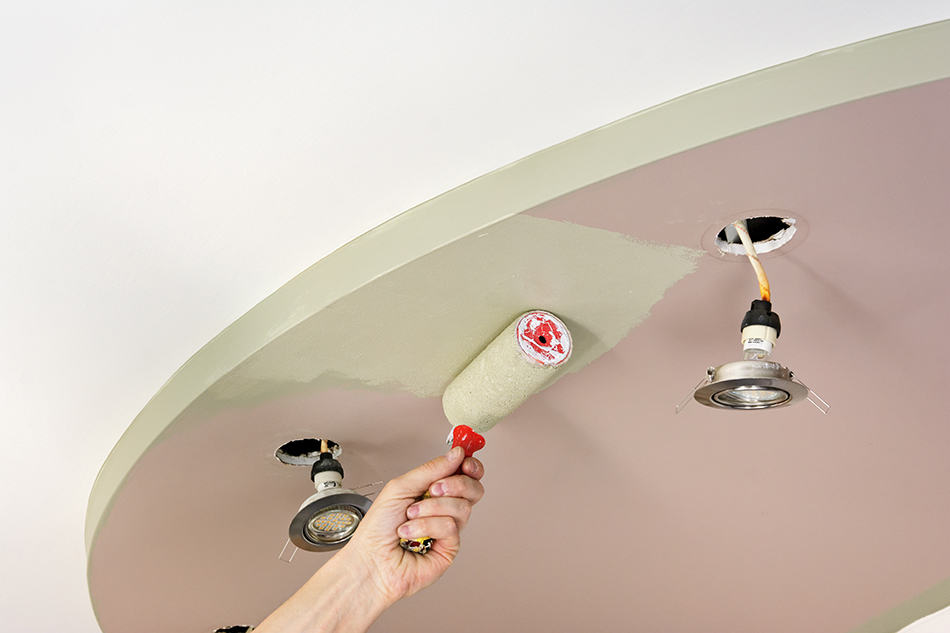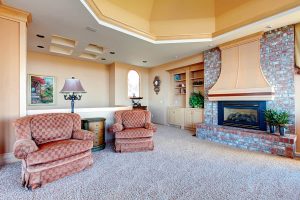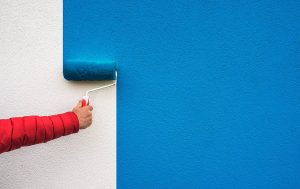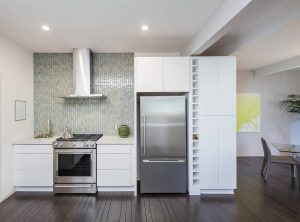A lot of people easily fall in love with eggshell paint, so much so that they prefer to have all the ceilings in their home painted eggshells. Many others, on the other hand, prefer their ceiling paints flat. This begs the question, “what informs these preferences’? In other words, what are the pros and cons of eggshell versus flat ceiling paint?
When picking out paint for walls, people often have endless options of colors and sheens to pick from, but when choosing paint for ceilings, the options are pretty limited. This is because people would hardly choose paints that are very glossy for their ceiling as this would draw too much attention to a ceiling, taking away attention from the décor of the rest of the room.
It’s been said that the color of your walls can affect the mood and appearance of the entire room; well, so does the color or sheen on the ceiling. So when it comes to painting the ceiling, the only question on many people’s minds is, ‘eggshell versus flat?’
Eggshell paint offers a slight sheen and is more durable than a flat paint, making it easier to clean. It is also highly resistant to moisture and stains, making it ideal for high-traffic areas like kitchens and bathrooms. In contrast, flat paint has no sheen and is better at concealing ceiling imperfections. It is a great option for rooms with low natural light or visible flaws. Ultimately, the decision between eggshell and flat paint depends on personal preference and the specific requirements of the room.
Benefits of Using Eggshell Paint for Ceiling
Eggshell paint is widely loved for its slight sheen; it’s just a little bit glossier than flat paint. Eggshell paint is just about as glossy as an actual eggshell. Anything glossier than that would be hard to roll on and too shiny for the ceiling because it would be distracting.
Not only is eggshell paint used for ceilings, but it’s also used in kitchens and bathrooms; this is because of how resistant it is to wear and tear, and is also pretty easy to clean when stained. The gloss on eggshell paint makes it easier to hide flaws on the paint so that not every imperfection on it appears very noticeable.
It is an eye-catching, multi-purpose paint sheen that brings out the best in your wall paint colors. Uneven textures, joints, and patches would be unnoticeable on flat paint. Finally, eggshell paint has a bit of gloss in it that prevents stains from soaking in. Here is a good eggshell paint product.
Disadvantages of Using Eggshell Paint for Ceiling
Eggshell paint is not as easy to apply as flat paint because glossy paint tends to overlap during application. Even though they are easy to clean when stained, when eggshell paint is rubbed, they take a visibly lighter color as some of its gloss is rubbed off.
Benefits of Using Flat Paint for Ceiling
Flat finish paint does not reflect as much light as eggshell paint, so it’s pretty easy to hide flaws in this kind of paint. This paint gives the most velvety, saturated, rich finish on a ceiling.
See an example of flat paint for the ceiling below.
Disadvantages of Using Flat Paint for Ceiling
Unfortunately, flat paint is not very durable, and neither is it easy to clean. Flat finishes are not very durable and need to be carefully cleaned. Generally, flat paint does not hold up well; however, when used on ceilings, they last longer than they do on walls because they’re less likely to get stained on the ceiling than on the wall.
Eggshell versus White for Kitchen Ceiling
The kitchen is the one room of the house where there is often an actual chance that grease or other stains may easily get up to the ceiling. While it’s really difficult to just wipe off flat paint, grease can easily be wiped off of eggshell paint. Eggshell is, therefore, a more durable option for one’s kitchen ceiling. However, flat paint works too if that’s your preference as they hide stains well.
Best Ceiling Paint to Hide Imperfections
Flat paint is the best ceiling paint for hiding imperfections. Its soft texture and matte finish absorbs light and helps hide any underlying blemishes. Yes, they do stain a lot easier than glossy paints, and they are a lot harder to clean once stained; however, because they do not reflect light, it would be pretty difficult to see the stains on them, especially if one is looking as far up as the ceiling.
Best Ceiling Paint for Textured Ceilings
Most people make the mistake of thinking they need to buy high-end paints or higher high-end designers to paint a textured ceiling; however, flat paint is the best ceiling paint to use for textured ceilings, and you can apply the paint yourself.
That’s why you’ll find that the majority of the ceiling paints you find in stores are flat paints. Unlike eggshell paint that overlaps during the application, flat paint is designed to bond perfectly with a primer which then seals the ceiling texture.
Can You Use Ceiling Paint on Walls and Wall Paint on Ceilings?
You’re better off using ceiling paint on ceilings and wall paints on walls for several reasons. Ceiling paints are designed to be thick and paint ceilings with no stress. Just a coat of ceiling paint on your ceiling can cover up all flaws with minimal splatter.
On the other hand, wall paint is often formulated to be thinner, and one might need more than two coats to perfectly coat a wall. Ceiling paint is designed to be dull and not bring too much attention to the ceiling; wall paint, on the other hand, is made to be bright and shiny to bring attention to the wall. This is to say that wall paint has different attributes and characteristics than ceiling paint. Such attributes include:
Make-up
Ceiling paint is typically designed to be flat. They do not reflect light, which means it’s easy for the paint to hide all flaws. They are vicious and hardly drip. Their composition allows them to cover imperfections a lot better. This composition is achieved at the expense of other paint characteristics not needed in the ceiling.
Durability
Paint on the wall is more susceptible to stains and other damage, so they’re designed to be easier to clean than ceiling paint. It’s easier to scrub a stain off wall paint without causing damage to the paint job than it is to scrub stains off the ceiling.
Colors
To make ceiling paint even easier to apply, the manufacturers often make it take a light blue or pink color when wet. Then it becomes white when dried out; this makes it easier to spot missed areas when painting and apply evenly to all spots. Ceiling paints also come in very limited colors, unlike wall paint which comes in several hues and finishes that ensures it can be used to create all kinds of fascinating designs and patterns.
Other Special Qualities
Various kinds of wall paints have qualities that ceiling paints may not possess. For instance, bathroom paint is often made to be resistant to mold, mildew, and even water.
How Many Coats Do You Need on the Ceiling?
Sometimes painting your ceiling with just one coat of paint can look good, just because ceiling paints are made thick enough to cover all flaws with one coat; however, you would often need a second coat just to make sure the final paint job has a uniform paint job.
If the color on your ceiling is darker than the new color you’re applying, you’ll also need at least two coats of paint to completely cover the darker color. So don’t be tempted to leave your ceiling with just one coat of paint, because chances are, you’ll be back in no time to repaint.
However, in some cases, some brands of ceiling paint are so well-fabricated that one only needs one coat of paint to do a perfect job. Also, if the old color on your ceiling is the same as the new color you’re having painted on your ceiling, then the old color can be used as a base, which means you’ll need only one more coat of paint.
Finally, if you use a primer first before applying paint, then you might need just one coat of paint to have a perfect paint job. If you’re applying more than one coat of paint, always make sure the first coat dries before applying another one over it, or else your paint would end up peeling and looking patchy.
Can You Paint A Ceiling with Just Primer?
Ever wondered if you can save time and money by just skipping the painting entirely and using a primer on your ceiling in place of paint? Well, you can, but chances are you’re going to regret this choice in little to no time.
A primer is only meant to prepare the surface that you wish to paint. When used as paint, it starts to look discolored after a short while. Also, when you use a primer as paint, blemishes on your wall remain visible, as opposed to when you use thick ceiling paint to cover up everything.
